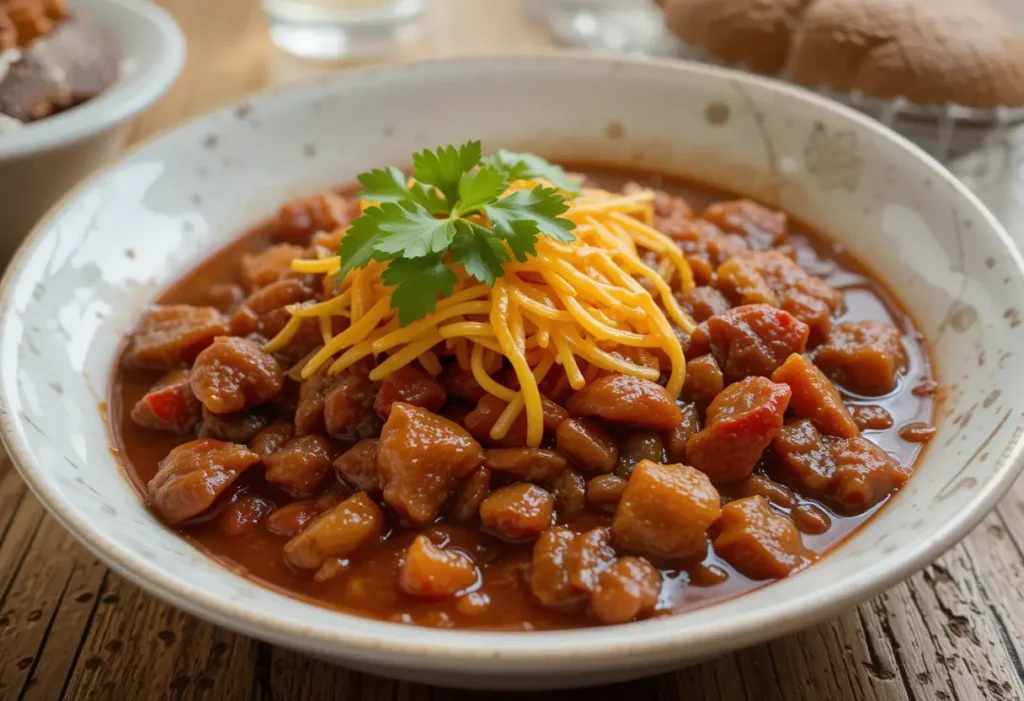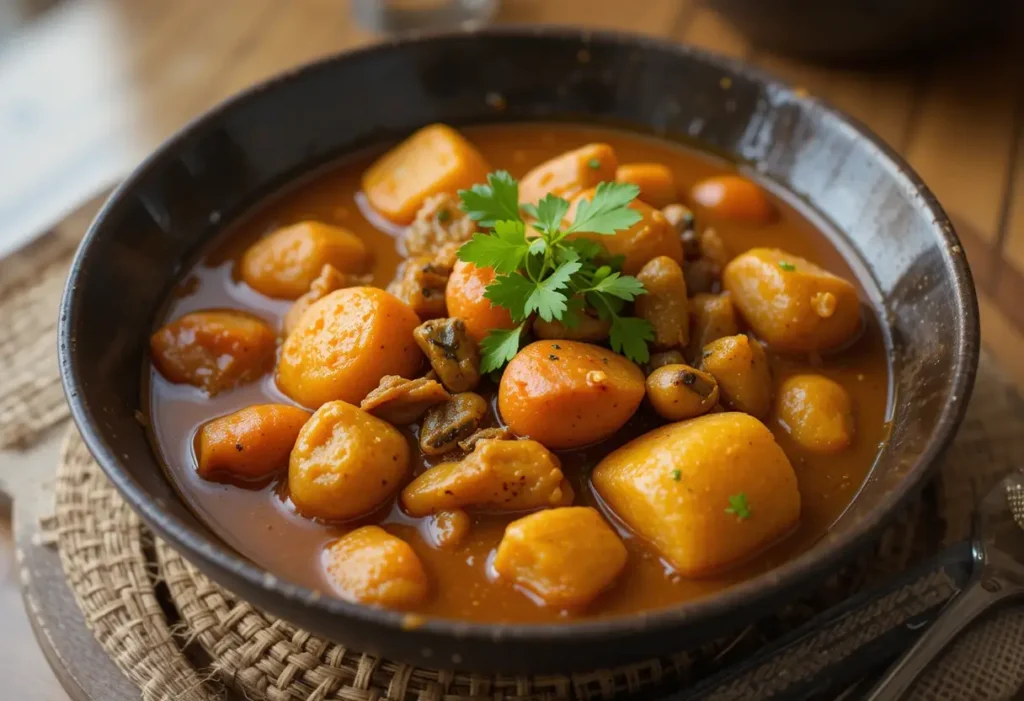Chili and stew are two beloved dishes enjoyed across cultures for their comforting flavors and versatility. While they are both hearty, one-pot meals, the differences between chili and stew lie in their unique ingredients, cooking techniques, and cultural origins. Understanding these distinctions helps highlight what makes each dish special and how they bring warmth and satisfaction to the table.
Table of Contents
Understanding the Basics of Chili
Origins and Cultural Significance
Chili, often referred to as “chili con carne,” originated in the Americas and has deep ties to Tex-Mex cuisine. This dish, traditionally made with chili peppers, meat, and spices, reflects a blend of Native American, Mexican, and Spanish influences. Over time, chili has become a symbol of culinary creativity in the United States, celebrated through cook-offs and regional variations.

Key Ingredients and Variations
The basic ingredients of chili typically include ground or diced meat (such as beef or turkey), chili peppers, tomatoes, beans, and a mix of spices like cumin, chili powder, and paprika. Variations include:
- Texas Chili: Focuses on meat and spices, without beans.
- Vegetarian Chili: Uses beans, lentils, or vegetables in place of meat.
- White Chicken Chili: Made with chicken, white beans, and green chilies for a milder flavor.
Chili’s adaptability allows cooks to experiment with different spice levels, proteins, and add-ins, making it a versatile dish for any taste.
Exploring the Essence of Stew
Historical Background
Stew has been a part of human culinary tradition for thousands of years. Its origins trace back to early cooking methods, where meat and vegetables were simmered in water or broth over open flames. Cultures around the world have developed their own versions of stew, from French boeuf bourguignon to Moroccan tagine, showcasing local ingredients and flavors.

Common Ingredients and Cooking Techniques
Stews typically combine meat (such as beef, lamb, or chicken), root vegetables (like potatoes, carrots, and parsnips), and a liquid base of broth, wine, or water. The slow cooking process allows flavors to meld and ingredients to become tender. Common techniques include:
- Browning the Meat: Adds depth to the stew’s flavor.
- Simmering: Ensures the meat and vegetables cook evenly and absorb the broth’s richness.
- Thickening the Sauce: Achieved with flour, cornstarch, or natural starches from the ingredients.
Stew’s hearty, comforting nature makes it a go-to dish for cold weather and family gatherings.
By understanding the basics of chili and stew, their origins, and cooking techniques, you can appreciate these classic dishes and experiment with your own flavorful creations. Whether you prefer the spicy kick of chili or the slow-cooked richness of stew, both offer endless possibilities for delicious meals.
Preparing Chili: A Step-by-Step Guide
Techniques for Maximizing Flavor
To make a great chili, focus on building layers of flavor. Start by browning the meat to create a rich base. Toasting spices like chili powder, cumin, and paprika in the pot before adding liquid enhances their aroma and taste. Incorporate ingredients like onions, garlic, and chili peppers early to infuse the dish with depth. For an extra boost, consider adding a splash of coffee, beer, or chocolate.
Cooking Times and Temperatures
Chili benefits from slow cooking, which allows the flavors to meld together. Simmer it on low to medium heat for at least an hour, stirring occasionally to prevent sticking. For a thicker consistency, let it cook uncovered during the final 20–30 minutes. Using a slow cooker or pressure cooker can also be an effective way to achieve the perfect texture and flavor.
Making Stew: Methods and Mastery
Slow Cooking Essentials
Stew relies on slow cooking to tenderize meat and bring out the natural sweetness of vegetables. Start by browning the meat to lock in its juices, then sauté aromatic vegetables like onions, celery, and carrots. Add liquid (broth, wine, or water) and simmer the stew over low heat for 2–4 hours. This gradual cooking process breaks down tougher cuts of meat and ensures a rich, hearty flavor.
Importance of Layering Flavors
Building layers of flavor is crucial for a delicious stew. Season the ingredients at different stages, beginning with salt and pepper for the meat and ending with fresh herbs like thyme or parsley just before serving. Using a combination of liquids (e.g., broth and wine) and including acidic ingredients like tomatoes or vinegar enhances the stew’s complexity.
Analyzing the Health Benefits of Chili
Nutritional Components
Chili provides a balanced mix of protein, fiber, and vitamins. The beans contribute fiber and plant-based protein, while the tomatoes add antioxidants like lycopene. Meat-based chili offers essential nutrients such as iron and zinc. The spices, particularly chili peppers, contain capsaicin, which may boost metabolism and reduce inflammation.
Dietary Considerations
Chili can be adapted to fit various dietary needs. For a lower-calorie option, use lean proteins like ground turkey or chicken. To reduce sodium, opt for low-sodium broth or canned tomatoes. Vegetarian versions with beans, lentils, and vegetables are also great for plant-based diets, offering plenty of fiber and protein.
Health Aspects of Stew
Caloric Content and Nutrients
Stew often contains nutrient-dense ingredients like root vegetables, lean proteins, and broth. It is rich in vitamins and minerals, such as vitamin A from carrots and potassium from potatoes. Depending on the recipe, calorie content can vary; lighter stews use lean meats and broth-based liquids, while cream-based stews are higher in calories.
Suitable Diets and Restrictions
Stew is highly customizable for different diets. For low-carb or keto diets, omit starchy vegetables like potatoes and use zucchini or cauliflower instead. Gluten-free versions can be made by thickening the liquid with cornstarch or potato starch. To lower fat content, trim excess fat from the meat or use chicken breast instead of red meat.
By mastering the techniques and understanding the nutritional value of chili and stew, you can create meals that are both flavorful and tailored to your dietary preferences. Whether you prefer the bold flavors of chili or the hearty warmth of stew, these dishes offer endless possibilities for satisfying and nutritious cooking.
Chili Across the World
American Chili Variations
In the United States, chili varies widely across regions. Texas chili, known as “chili con carne,” is meat-focused and excludes beans, making it rich and hearty. For a unique twist, check out recipes like the Spicy Rigatoni for bold flavor inspiration. Meanwhile, Cincinnati chili incorporates sweet spices such as cinnamon and is traditionally served over spaghetti.
International Takes on Chili
Globally, chili is adapted to suit diverse tastes. In Mexico, chili verde combines pork and green chilies for a zesty dish. For a lighter take, you might enjoy recipes like the Mediterranean Salmon, which incorporate fresh ingredients and unique flavors. In India, lentils or chickpeas are often used in spicy chili-inspired curries, showcasing the versatility of the dish.
Stew in Different Cultures
European Influences
European stews emphasize rich, traditional flavors. French boeuf bourguignon uses red wine to braise beef, creating a deep, savory taste. For inspiration on hearty recipes, try a dish like the Beef Sausage Recipes, which demonstrates how robust ingredients enhance meals. Meanwhile, Irish stew, featuring lamb and root vegetables, highlights the simplicity of comfort food.
Stew in Asian Cuisines
Asian stews bring bold and unique flavors to the table. Japanese nikujaga combines potatoes and thinly sliced beef in a soy-based broth, while kimchi jjigae in Korea uses fermented kimchi for a tangy kick. Explore dishes with an Asian-inspired touch, like the Seafood Enchiladas, which offer a blend of spice and freshness.
Expert Tips for Perfect Chili
Choosing the Right Ingredients
Using fresh, high-quality ingredients is key to making great chili. Tomatoes—whether fresh or canned—form the flavorful base, while proteins like beef, turkey, or chicken add heartiness. For plant-based options, beans and lentils work wonderfully. Recipes like the Vegetarian Lasagna Soup showcase how versatile ingredients can transform a dish.
Secrets to Serving and Garnishing
Serve chili hot in bowls and garnish with toppings to elevate its presentation. Options like shredded cheese, sour cream, or fresh cilantro enhance the flavor. For added texture, pair the chili with tortilla chips or bread. For a similar comforting experience, try the Pumpkin Banana Loaf as a side or dessert.
Mastering the Art of Stew
Best Practices for Preparation
The best stews start with browning the meat to build a rich flavor base. Vegetables such as onions, garlic, and celery should be sautéed before adding liquids like broth or wine. Slow simmering is essential to achieve tender meat and harmonious flavors. Recipes like the Spaghetti Casserole demonstrate the power of slow cooking for deep, savory dishes.
Serving Suggestions
Serve stew in deep bowls, accompanied by sides like crusty bread or rice to soak up the flavorful broth. For additional garnishing ideas, fresh herbs like parsley or thyme can brighten the dish. To explore comforting meal options, the Sweet Potato Cornbread pairs beautifully with hearty stews.
By incorporating these practical tips and exploring chili and stew variations, you can expand your culinary repertoire. Whether you’re recreating a spicy chili with creative toppings or perfecting a traditional stew with bold flavors, recipes like those found at Diversity Recipes can inspire and guide your cooking adventures.
Frequently Asked Questions About The Difference Between Chili and Stew
What Makes Chili Different From Stew?
The primary difference lies in their consistency and ingredients. Chili is typically thicker, made with ground or chopped meat, chili peppers, and often beans, giving it a hearty and spicy profile. Stew, on the other hand, is a liquid-heavy dish with chunks of meat and vegetables simmered in broth or wine, resulting in a more soupy texture. Both are versatile and adaptable to different flavor profiles.
Can Chili or Stew Be Considered a Health Food?
Yes, both can be healthy when prepared with nutritious ingredients. Chili made with lean protein, beans, and tomatoes offers a balance of protein, fiber, and antioxidants. Stew, packed with vegetables and lean meats, is rich in vitamins and minerals.
What Are the Best Occasions to Serve These Dishes?
Chili and stew are excellent choices for casual gatherings, family dinners, or cold-weather meals. Chili is a crowd-pleaser at game days or potlucks, while stew provides a comforting option for Sunday dinners or festive occasions.
How Can I Modify Recipes for Dietary Restrictions?
Both dishes are highly adaptable:
For Vegetarian or Vegan Options: Replace meat with beans, lentils, or tofu. The Seafood Enchiladas can also be modified by substituting seafood with vegetables.
For Gluten-Free Needs: Use gluten-free thickening agents like cornstarch or potato starch for stews. Avoid bread sides and opt for gluten-free options.
For Low-Carb Diets: Reduce starchy vegetables in stews and skip beans in chili, focusing on low-carb substitutes like zucchini or cauliflower.
Tips for Preserving and Reheating
Storing: Let the dish cool completely before transferring it to airtight containers. Store in the refrigerator for up to 3–5 days.
Freezing: Both chili and stew freeze well. Divide them into single-portion containers to make reheating easier.
Reheating: Reheat on the stovetop over medium heat, adding a splash of water or broth if the consistency has thickened. Stir occasionally to ensure even heating.
Avoid Overcooking: Overheating can affect texture, so warm just until steaming.
This FAQ section addresses common questions to help you enjoy chili and stew to the fullest. Whether you’re preparing for a special occasion or accommodating dietary needs, these tips ensure every dish is flavorful, convenient, and suited to your lifestyle.
Conclusion
Chili and stew are comforting dishes that bring flavor and warmth to any meal. While chili is bold, spicy, and thicker in texture, stew offers a savory, slow-cooked experience with tender meat and vegetables. Each dish suits different occasions—chili shines at casual gatherings, while stew excels as a hearty family dinner. Both are versatile, easily adapting to dietary needs like vegetarian, gluten-free, or low-carb options. By experimenting with ingredients and techniques, you can create personalized versions of these classics. Whether you prefer chili’s fiery kick or stew’s comforting richness, both promise satisfying meals full of flavor and heart.

